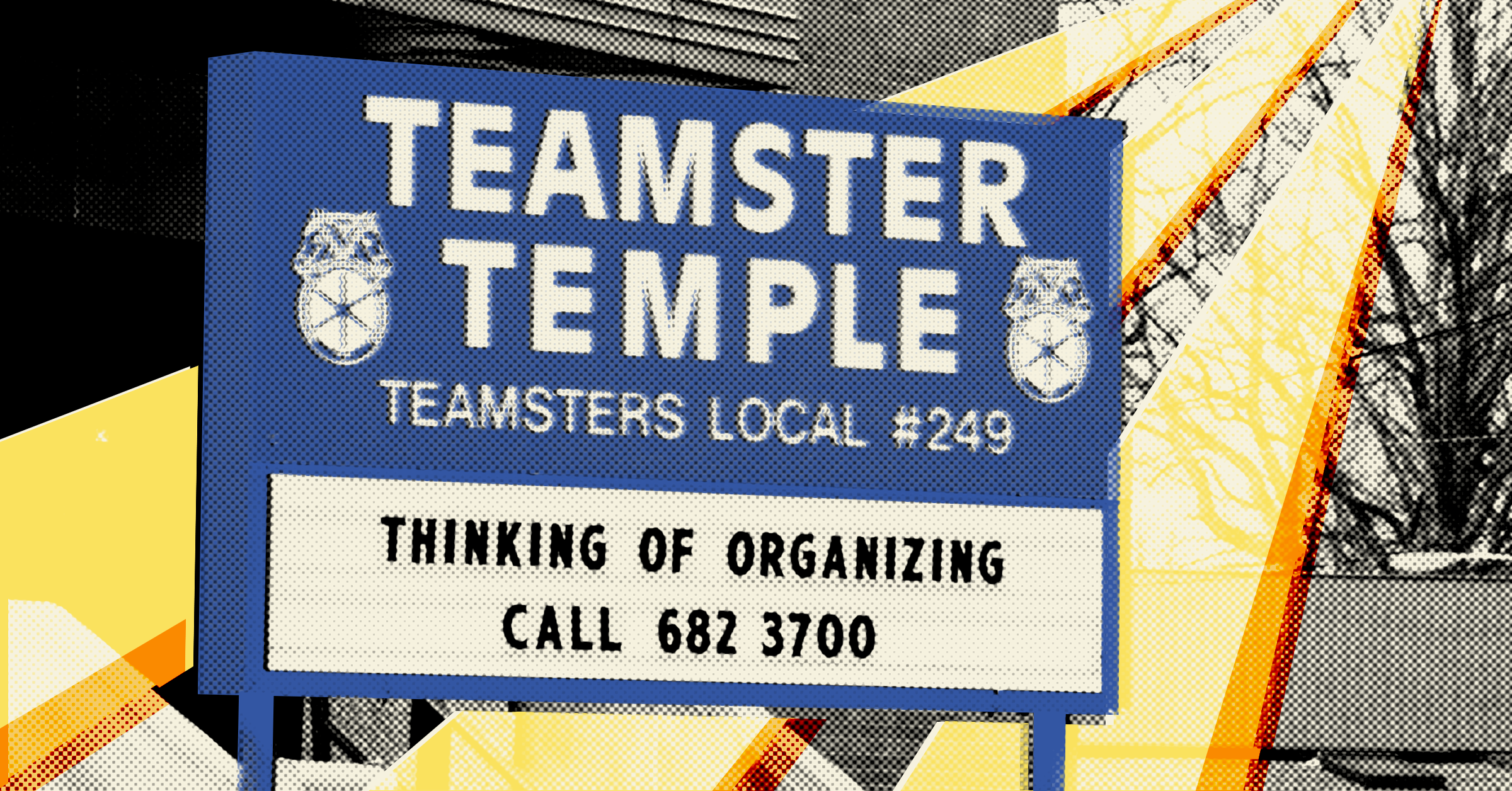In November 2021 a reform slate won the national leadership elections in the International Brotherhood of Teamsters. Within one of the most powerful unions in the U.S., with 1.3 million members, a new chapter of democratization and reorientation toward class struggle unionism could be opening.
The reform slate Teamsters United promised to bargain hard against UPS in 2023, organize Amazon, and contribute to rebuilding labor. While some of the reformers came from within the old machine that ran the Teamsters bureaucratically through business unionism, the change is still a major accomplishment that could open the floodgates for rank-and-file self-empowerment in coming Teamster struggles.
There’s no guarantee this will be the case — but DSA members can and should help to revive the proud, militant traditions of the self-described “World’s Most Powerful Union.”
Where Things Are
The reform slate, known both as “OZ” for its top officers Sean O’Brien and Fred Zuckerman and by its official name Teamsters United (TU), won every U.S. region. It won 3 to 1 in the South, Central, and Eastern regions, and in the Western region with 56 percent, losing only the Canadian region with 25 percent.
This victory was partly a response to brutal setbacks in the 2018 UPS contract, which instituted a two-tier contract for drivers, the most engaged and militant section of the UPS workforce.
Sean O’Brien, president of Local 25 in Boston and lead negotiator for the International’s package division, was fired from that role in 2017 by President James P. Hoffa, for his confrontational style of negotiating. The “Vote No” movement and anger resulting from the sellout 2018 contract built the apparatus of the successful 2021 Teamsters United campaign.
In summer 2023 the UPS contract will expire. The TU Slate took aim at the two-tier system and also vowed to strengthen language for the part-time workers who make up a big part of the UPS workforce. Some 300,000 members work at UPS and their contract is what other unionized firms often look to as a standard across industries.
While many activists believe the Teamsters will authorize a strike at UPS in 2023 through a membership vote, there is no guarantee the trigger will be pulled. It’s not likely that the regular bargaining process will eliminate the tiers or make substantial gains for part-timers without a strong commitment to internal organizing. The time for that organizing is now!
Critics of the Teamsters United slate argue that the low election turnout shows members’ lack of engagement in the union and underlines its decline. However, the low turnout is a double-edged sword. It is a tragic fact that fewer members voted in this election than in any election since the start of one-member-one-vote elections in 1991. But we also now have an opportunity for a new generation of Teamsters to transform it toward a class struggle orientation. Moreover, Teamsters locals with the highest victory margins for TU, such as 705 in Chicago and 804 in New York, among others, did show an increase in turnout.
The Teamsters United slate has been criticized for being insufficiently dedicated to reform, with only a quarter to a third of its members coming from the decades-old reform caucus Teamsters for a Democratic Union (TDU). However, because TDU activists were some of the most dedicated and crucial members among the rank-and-file driving turnout for the election, and because TDU remains able to mobilize large numbers of rank-and-file leaders, it had a disproportionately important role in platform construction and in the TU victory, which suggests it will continue to play a major part in the new administration.
Before a single vote was cast, TDU had accomplished two critically necessary reforms which, even had TU been defeated, would still have put power back into the hands of rank-and-file members at contract time. Mandating that rank-and-file workers be on all Teamsters bargaining committees and eliminating the infamous “two-thirds rule” for contract ratification were major victories. “Two-thirds” was the tool the Hoffa administration used to approve the 2018 UPS contract that introduced two-tier pay, despite a majority of the voting members rejecting it.
Organizing in good faith with the incoming leadership alongside independent rank-and-file meetings, committees, social media groups, and networks to mobilize our members towards a necessary showdown with UPS in 2023 is the most viable path to putting the fight back into our union.
What Do We Need to Accomplish?
The last time UPS was struck successfully was 1997, when an unprecedented contract campaign fueled by rank-and-file participation led to a 15-day strike. It succeeded in disrupting 5 percent of Gross National Product and in winning 10,000 new full-time positions, a 50 percent increase in pension contributions, and the biggest pay increases in any UPS contract before or since.
Major contract wins like these, achieved through the self-activity and struggle of workers ourselves, is exactly what we need if we are going to build the militancy of the Teamsters and demonstrate to unorganized workers that their best shot at a better life is through a union.
While UPS Teamsters, especially full-timers, are proud of their high pay and look forward to a dignified retirement, in order to secure that income it has become the norm to work 50+-hour weeks, even for high-seniority top-tier drivers.
The second-tier drivers, the “22-4’s,” often work six-day weeks; maxing out on hours (working the Department of Transportation maximum allowance for commercial drivers) at 60 per week is a standard occurrence. The 22-4’s can be forced to work the sixth day and have no right to bid for a route of their own. They are paid a full $10 less per hour at the top of their wage progression than regular drivers, despite performing the exact same job, often covering the delivery routes of regular drivers when they take vacation or sick time.
The issue, however, is beyond contractual terms. Overwork has become ingrained in the culture of many UPS shops, where even top-scale drivers accept 10-hour days and more as the norm because of the lucrative overtime pay. It’s analogous to a quote from a striking John Deere UAW worker: “You can make a lot of money if you live there.”
The base salary at 40 hours per week for a top-scale driver is around $76,000 per year, not counting benefits or pension contributions. Workers rely on overtime to boost their annual earnings to well over $100k. It’s the kind of money that allows UPS drivers long-term financial stability, home ownership, sending children to college, and even living in single-income households. In order to access that standard of living, though, what they give up is the time to enjoy it.
Because of the demands of the high-volume Peak Season, many have come to dread the holidays, which mean shivering in a poorly loaded package car in the dead of night or cramming endless package volume into trucks, trailers, and delivery cars in the chaos of an overloaded UPS hub.
UPSers need a better deal. We must demand a contract that will expand the pay and benefits that have been stagnant in the 25 years since the 1997 strike to the point that overtime pay becomes truly punitive to the company, so workers can have both generous pay and the time to enjoy it with their families. Asserting those demands, building the internal support necessary for them, and holding our new leadership to the promises that swept them into office will be the work of socialists and activists within the Teamsters and the communities where we live and work.
How Can the Socialist Movement Pull the Trigger?
The 1997 contract campaign initiated by former Teamster president Ron Carey — himself elected because of a rank-and-file upsurge — relied on mobilizing members. It’s a model we should learn from. We have a tool, however, that Carey never had: the emergence of a socialist movement committed to building working-class power through militant unions.
DSA committed itself at its 2019 and 2021 conventions to wholeheartedly support labor struggles and organizing, aspiring to once again merge the socialist movement with the labor movement. Though we are still in the early stages of our labor organizing in DSA, we have made some major strides in supporting labor struggles.
Chapters such as East Bay, Chicago, Los Angeles, and New York DSA were early leaders in engaging with and encouraging militant organizing, experimenting with building community support during the teachers’ strikes. Since 2020, chapters across the country have developed various methods of assisting workers in their struggle against the boss.
Portland DSA is developing a model of socialist labor activism that could be replicated to build an integrated national network that can help to mobilize the UPS workers who make up one of the most strategic blocs of organized labor in the American economy.
The Portland Model at UPS
In six months of intense campaigning for the TU slate on the job site, we’ve assembled a team of over a dozen DSA members who are Teamsters. We meet regularly and are working on mapping our workplaces, planning to support contract campaigns for smaller shops within the local, building relationships with union officers, and having regular organizing conversations with rank-and-file workers to begin increasing the average worker’s engagement with our union.
We are organizing through our Labor Working Group’s Logistics Sub-Committee. We have convinced a number of DSAers to work at UPS, which has a low barrier to entry. With “the great resignation” underway, it is relatively easy to convince workers in DSA to leave dead-end jobs and become employed by “Big Brown,” with the promise of high wages, job security, healthcare, and a role in organizing for what is shaping up to be a historic contract campaign.
UPS is a high-turnover shop, but with early intervention by higher-seniority employees we have been able to prepare new recruits for the pre-seniority period by focusing on stress management, physical safety, and a social support system to aid in adjusting to a demanding workplace. It is best to recruit people to UPS either well before or after peak season, as there are typically informal layoffs by the company at the end of that season.
Our plan is to organize projects within the workplace and the local, build relationships among rank-and-filers and with local officers to aid our understanding of the political situation within our union, and build our own competency ahead of the contract campaign. While the 2021 election provided us with the perfect opportunity to do all of this — operating in good faith with local leaders who had a stake in a TU victory — socialist organizers will need to be creative going forward.
Our long-term goal is an empowered rank and file capable of militant, democratic unionism. The shared projects of reform and aggressive contract negotiation have allowed us to organize openly among our co-workers, make asks of union officers to assess their political priorities and test limits of their solidarity, and gain familiarity with the Teamster bureaucracy, all without backlash from our leadership.
Now we are orienting toward smaller contract campaigns as dry-runs for UPS in 2023. Our hope is that campaigns at smaller shops will gain us experience, and should those workers decide to strike we hope to turn UPSers out to the picket lines, something few of our co-workers have ever experienced.
Additionally, the Portland DSA Labor Working group is earning a reputation among local unions as a capable and valuable ally for strikers, ever since the stunning success of our campaign to support the Bakery union’s 2021 strike at Nabisco.
In an early demonstration of how our groundwork is paying off, DSA members successfully pushed for Teamsters Joint Council 37 to endorse UFCW Local 555’s strike of Kroger-owned grocery chains. DSA members on picket lines were able to turn trucks away from the delivery docks and teach striking workers to do the same.
We believe this kind of engagement is invaluable for assessing the organizing needed, helping to build the muscle we will need in 2023.
Taking the Portland Model Nationwide
The Portland Model involved active recruitment of unemployed and underemployed socialists, cadre building in the Labor Working Group, organizing rank and file workers, assessing local leadership, and participating in strike support and other actions that engaged rank and file Teamsters. But we need a national network built through DSA’s Democratic Socialist Labor Commission (DSLC) to help socialists build influence in Teamster locals across the country in preparation for 2023.
We have benefited immensely from an informal network of UPSers and DSA labor organizers locally and across the country. Formalizing that network and building its capacity will be essential for socialists to play a meaningful role in the 2023 UPS contract fight, which has the potential to be the largest labor struggle in more than 25 years.
In order to form the national structure needed for that campaign and follow it up by organizing employers like Amazon and FedEx, we will need to hold a conference to promote the project within DSA, draw labor organizers into supporting the project, and educate potential rank and filers on how to get hired at UPS, survive their pre-seniority period, and begin shop floor organizing.
The conference could also inform members of other unions on the upcoming struggle at UPS. A reinvigorated, fighting Teamsters union would have an impact on many other labor struggles. In our time on picket lines at Nabisco and UFCW, both the power workers feel and the pain on the faces of the bosses when Teamsters honored the picket line was instrumental in helping those workers extract concessions. Bakery union workers told us every day, “When you go out, we will be there for you on day one.”
Building that solidarity early will strengthen our position as Teamsters if we do walk out and bolster the standing of DSA as a serious and committed partner capable of support that matters.
DSA’s labor staffer should dedicate some of their time to working with the newly formed Logistics Subcommittee of the DSLC. The staffer should help build out structures within the subcommittee for specific workplaces: UPS, Amazon, FedEx, DHL, and other delivery firms. For UPS and DHL, both Teamster-represented, these structures should be geared towards contract campaigns. Amazon and FedEx efforts should be focused on recruiting salts for long-term union organizing.
Democratic Left, print and website, could contain regular updates.
Get a Job at UPS, Build the Union, Engage in Class Struggle with 300,000 Teamsters
Get a job at UPS and engage in the struggle of 300,000 Teamsters, coordinating with dozens of DSA members across the country. Be the eyes and ears in your shop and local and become a rank-and-file leader. UPS has locations across the country, all of them offering at least $15 an hour for part-time inside pay plus health insurance. If you decide that this is the role for you, then UPS is a place you can have a long-term career as a driver in a union shop. This can be a great way to build your DSA chapter’s presence in the labor movement and it’s an opportunity for YDSAers: UPS offers an “earn while you learn” program that pays $5,000 per year towards your studies. Get paid to strengthen the labor movement and build a home for socialist politics in a strategic, powerful union.
Our contract expires in July 2023. Join us in organizing a massive grassroots contract campaign. The ideal time to get hired is spring through fall of this year. These are entry-level jobs that don’t discriminate based on education.
The journey towards unionizing Amazon will be led through Big Brown. Take the journey with comrades.
A longer version of this article appeared in Reform & Revolution — written before the stunning victory at Amazon Staten Island.




